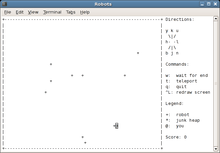robots (computer game)
robots is a computer game that was developed for the Unix-based operating system Berkeley Software Distribution by Ken Arnold. In this turn-based game, players are tasked with escaping from robots programmed to pursue and kill them. The BSD Unix version of robots first appeared in the 4.3BSD software release in June 1986.[1][2]
In May 1985, a very similar game also called robots, written by Allan R. Black, was posted to the Usenet newsgroup net.sources.games.[3][4]
Gameplay
robots is played on a two-dimensional rectangular grid. The objective of the game is to escape from a number of robots, which have been programmed with only a single objective: to kill the player.

The game is turn-based. In the original game the player character starts at a randomly selected location. In some derivative versions, such as the GNOME version, the player starts at the centre of the grid. The robots start at randomly selected locations on the grid. Every time the player character moves a square in any direction (horizontally, vertically, or diagonally), each robot moves one square closer to him, in whichever direction is the shortest way.
If the player character collides with a robot, he dies and the game ends. However, the robots are also fatal to each other - when two robots collide, they both die, leaving behind a scrap heap. These scrap heaps are also fatal to robots and the player.
The player can also teleport into a randomly selected location in cases where escape is otherwise impossible. A teleportation counts as a move. However, because the location is randomly selected, it is possible that the player teleports right into the path of a robot. In some versions of the game, there is a "safe teleport" feature which the player may use a limited number of times (for instance once per level) and there may also be a close-range weapon which kills all robots within the immediate vicinity, the use of which would be limited in a similar way.
When all robots on a level are dead, the player moves onto another level, with more robots. Traditionally, the number of robots increases by ten each level.

Other versions
In the Jan-Feb 1976 issue of Creative Computing, a game called Chase was published that bears a strong resemblance to robots. The author was originally listed as "Unknown," with modifications attributed to Bill Cotter.[5][6][7][8]
In 1983, Tim Hartnell and Nathan Butcher wrote a game in BASIC called Robot Minefield, which involved fleeing from four robots on a small field of landmines. The game was more difficult than robots since the player lacked the ability to teleport. Moreover, robots could merge into each other without being destroyed. In addition, the player could only move in four directions (North, South, East, West) while the robots had the ability to move diagonally. The game was played in real time; as the player pondered his move, the robots would continue converging toward him. This version was published in the 1983 Giant Book of Computer Games.[9][10]
In 1984, Johan Strandberg published a game called Daleks, for the Macintosh.[11]
In May 1985, a very similar game also called robots, written by Allan R. Black, was posted to the Usenet newsgroup net.sources.games.[3][4]
In 1985, Robert Paauwe of Softstar Software developed a derivative called Daleks, for DOS.[12]
In 1987, Graeme Lunt and Julian Onions developed a derivative of Allan Black's code, called robots2, which they posted to the comp.sources.games Usenet newsgroup.[13][14]
In 1989, a variant called Robots from Hell was published by William R. Voss. Played on a screen of blue tiles, the robots can not overlap, nor are scrap heaps formed. There are several humorous elements added to the game, such as comments when the player dies, or text reminding the player they have scrolled past the end of the instructions when viewing the game rules.[15]
In 1991, Nicholas Lonsky published a port called Tobor, for Windows 3.0.[16]
In 1995, Torbjörn Andersson published a derivative called Robots, for the Z-machine.[17]
In 1998, Mark Rae published a derivative called Gnobots, later called GNOME Robots, for GNOME.[18][19]
In 1999, Mark Cenicola of Cenic's Soft published a derivative called Trolls for Mac OS 7.0 or greater.[20]
In 2008, John Matthews published a derivative called RobotChase, for the Java software platform.[21]
See also
- Robotron: 2084, a real-time version
References
- ↑ 4.3BSD robots(6) man page
- ↑ 4.3BSD robots source code
- 1 2 Stephen J. Muir (May 28, 1985). "Robots game for 4.2 BSD (highly addictive).". Newsgroup: net.sources.games. Usenet: 149@dcl-cs.UUCP. Retrieved August 21, 2015.
- 1 2 robots, by Allan R. Black
- ↑ Creative Computing volume 2, issue 1, pages 75-76
- ↑ Chase (first page)
- ↑ Chase (second page)
- ↑ Chase (additional detail from 1979)
- ↑ GameBase64: Robot Minefield
- ↑ Tim Hartnell's Giant Book of Computer Games, p.273: Robot Minefield
- ↑ Daleks, by Johan Strandberg
- ↑ Daleks, by Robert Paauwe
- ↑ Julian Onions (July 8, 1987). "v01i080: robots2 - Game of robots, version 2". Newsgroup: comp.sources.games. Usenet: 1380@tekred.TEK.COM. Retrieved August 16, 2015.
- ↑ "GitHub: robots2 - Game of robots, version 2". Retrieved August 16, 2015.
- ↑ William R. Voss (1989). "Robots from Hell". Retrieved April 17, 2016.
- ↑ Tobor, by Nicholas Lonsky
- ↑ Robots, by Torbjörn Andersson
- ↑ Gnobots - Robots game for Gnome, by Mark Rae
- ↑ GNOME Robots
- ↑ "Trolls 1.3.1 - Mark A. Cenicola". Retrieved 2015-12-03.
- ↑ RobotChase, by John Matthews